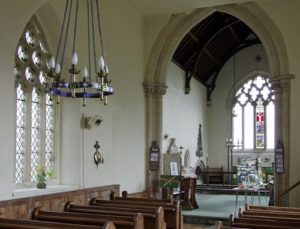Sibthorpe is a tiny settlement in the depths of rural Nottinghamshire which is now growing rapidly as an upmarket dormitory village for Newark or Nottingham. On the edge of the village is the delightful small church, set in a sleepy graveyard, all that remains of the medieval settlement. To the east of the church is one of the best preserved 14thC dovecotes in England. There are traces of ridge and furrow and the hollows in the ground are remains of medieval fish ponds. It is thought these were originally part of a college of Priest attached to the church. A priest and eight or nine chaplains were based here and officiated daily at the neighbouring churches.
The church is open during day light hours but receives few visitors. We visited as part of the Nottinghamshire Open Churches Weekend and were given a warm welcome by the church warden. It was past one a clock and we were his first visitors.
From the outside it is a rather plain building with a low 13thC tower with double buttresses at the corners, a flat roof, low nave and slightly higher chancel. It had been bigger but the aisles were demolished in the 17thC. The nave was reconstructed in the 18thC explaining the lower roof line.
Inside it is a delightful small church and it is obvious it is lovingly cared for. Inside is a stone font dated 1662, set on an octagonal stand. The bowl is decorated with carved panels with a diagonal cross. There is low wooden panelling around the walls and golden brown pews. The oak pulpit and lectern are modern.
With whitewashed walls and large plain glass windows, it is a light and airy church. The windows on the north wall date from the medieval church. Those on the south wall are early Georgian. The mullions were put in by the Victorians to ‘Gothize’ them.
Walls are covered with whitewashed plaster and there is a flat plaster roof in the nave, put in during the 1770 alterations, which partially obstructs the pointed chancel arch with carved capitals.
A step leads up into the chancel with wooden beam roof and a simple wooden altar covered with an embroidered cloth, with wooden candle sticks and cross. It is surrounded on three sides by four very tall candle sticks joined by a metal rail. Hereby hangs a tail. The Duke of Portland gave money for the restoration of the church in 1919. This included the candlesticks with green velvet hangings to surround the altar. After only a few years they were ‘lent’ to Fledborough Church and forgotten about. After 41 years, the churchwarden found the paperwork relating to this and rang up Fledborough to reclaim the candlesticks. Their comment was “we knew they were on loan, but had forgotten who loaned them to us…” They are now back where they belong but are awaiting new green velvet hangings.
The east window has a central panel of late 19thC stained glass. At the top is a pelican plucking its breast to feed her young. In the centre is a scene of the crucifixion with Jesus on the cross with the Virgin Mary and St John. At the base is a serpent coiled round a cross as Jesus is teaching the lesson of John 3v14 “And as Moses lifted up the serpent in the wilderness, so shall the Son of Man be lifted up”.
On the north wall is a splendid alabaster memorial of Edward Burnell dated 1589. On the base is a blank shield held by two figures. Above is the praying figure of Edward Burnell dressed in flowing robes and wearing a ruff. His head is resting on a Bible. At his feet is a grinning skull. The damage to the eyes was caused by the Victorians who took exception to the skull and screwed a shield over it.
I’m saving the best until last… Pride of place in the church must go to the delightful Easter Sepulchre on the north wall. At the base is a tomb recess with a tomb slab with a caved cross. On the arch is a well worn Latin inscription.
Above is the niche set under an ogee arch which would have received the consecrated Host on Good Friday until Easter morning. Very early, it was taken out to the singing of anthems and was carried to the high altar, so symbolising the death and resurrection of Christ.
On either side are two panels with painted figures of the sleeping Roman soldiers guarding the tomb. They are wearing medieval chain mail armour and holding a sword and shield.
Above is a steeply pointed gable with green leaves carved on the sides and a green finial. In the centre is the painted figure of the risen Christ giving a blessing with his right hand. In his left hand he is holding a staff with a cross at the top and small red pennant. At his feet are two angels in blue robes with censors. At the base are two praying figures.
The sepulchre was repainted in the 19thC. Unfortunately the person didn’t know their gospel story as the soldier were painted with open eyes. The Victorian paint has been carefully removed leaving the original medieval paintwork.
This is a delightful little church and really is a hidden gem. It is well worth a visit. Visit website.








